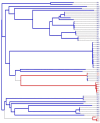A genome-wide investigation of Mycoplasma hominis genes associated with gynecological infections or infertility
- PMID: 40371111
- PMCID: PMC12075135
- DOI: 10.3389/fmicb.2025.1561378
A genome-wide investigation of Mycoplasma hominis genes associated with gynecological infections or infertility
Abstract
Background and aim: Mycoplasma hominis is a human pathogenic bacterium that causes a wide range of genital infections and reproductive issues. Previously, based on an extended multilocus sequence typing scheme, we provided evidence for the segregation of M. hominis clinical strains into two distinct pathotypes: gynecological infections or infertility. Here, based on whole genome sequencing (WGS) data, we sought to provide a more refined picture of the phylogenetic relationship between these two M. hominis pathotypes, with the aim to delineate the underlying genetic determinants.
Methods: We carried out WGS of 62 Tunisian M. hominis clinical strains collected over a 17-year period. The majority of these clinical strains are associated with infertility (n = 53) and the remaining nine isolates are from gynecological infections cases. An alignment-free distance-based procedure (Jolytree) was used to infer phylogenetic relationships among M. hominis isolates, while the phylogenetic method treeWAS was used to determine the statistical association between pathotypes of interest and genotypes at all loci.
Results: The total pangenome of M. hominis strains was found to contain 1,590 genes including 966 core genes and 592 accessory genes, representing 60 and 37% of the total genome, respectively. Collectively, phylogenetic analyses based on WGS confirmed the distinction between the two M. hominis pathotypes. Strikingly, genome wide association analyses identified 4 virulence genes associated with gynecological infections, mainly involved in nucleotide salvage pathways and tolerance to oxidative stress, while five genes have been associated with infertility cases, two of which are implicated in biofilm formation.
Conclusion: In sum, this study further established the categorization of M. hominis into two pathotypes, and led to the identification of the associated genetic loci, thus holding out promising prospects for a better understanding of the differential interaction of M. hominis with its host.
Keywords: Mycoplasma hominis; genome-wide association studies; gynecological infections; infertility; pathotype; virulence; whole genome sequencing.
Copyright © 2025 Chibani, Yacoub, Boujemaa, Mardassi, Guglielmini, Vaysse, Khadraoui, Mlik and Ben Abdelmoumen Mardassi.
Conflict of interest statement
The authors declare that the research was conducted in the absence of any commercial or financial relationships that could be construed as a potential conflict of interest.
Figures




Similar articles
-
Phylogenetics of Mycoplasma hominis clinical strains associated with gynecological infections or infertility as disclosed by an expanded multilocus sequence typing scheme.Sci Rep. 2018 Oct 5;8(1):14854. doi: 10.1038/s41598-018-33260-x. Sci Rep. 2018. PMID: 30291332 Free PMC article.
-
Sequence analysis reveals asymptomatic infection with Mycoplasma hominis and Ureaplasma urealyticum possibly leads to infertility in females: A cross-sectional study.Int J Reprod Biomed. 2021 Dec 13;19(11):951-958. doi: 10.18502/ijrm.v19i11.9910. eCollection 2021 Nov. Int J Reprod Biomed. 2021. PMID: 34977452 Free PMC article.
-
Genetic variability of the P120' surface protein gene of Mycoplasma hominis isolates recovered from Tunisian patients with uro-genital and infertility disorders.BMC Infect Dis. 2007 Dec 5;7:142. doi: 10.1186/1471-2334-7-142. BMC Infect Dis. 2007. PMID: 18053243 Free PMC article.
-
Epidemiology of genital infections caused by Mycoplasma hominis, M. genitalium and Ureaplasma urealyticum in Iran; a systematic review and meta-analysis study (2000-2019).BMC Public Health. 2020 Jun 29;20(1):1020. doi: 10.1186/s12889-020-08962-5. BMC Public Health. 2020. PMID: 32600306 Free PMC article.
-
Molecular dissection of Mycoplasma hominis.APMIS Suppl. 2000;97:1-45. APMIS Suppl. 2000. PMID: 10721331 Review.
References
-
- Allen-Daniels M. J., Serrano M. G., Pflugner L. P., Jennifer M. F., Melissa A. P., Vishal N. K., et al. . (2015). Identification of a gene in Mycoplasma hominis associated with preterm birth and microbial burden in intraamniotic infection. Am. J. Obstet. Gynecol. 212, 779.e1–779.e13. 10.1016/j.ajog.2015.01.032 - DOI - PMC - PubMed
-
- Ben Abdelmoumen Mardassi B., Ayari H., Béjaoui-Khiari A., Mlik B., Moalla I., Amouna F. (2007). Genetic variability of the P120′ surface protein gene of Mycoplasma hominis isolates recovered from Tunisian patients with uro-genital and infertility disorders. BMC Infect. Dis. 7, 142. 10.1186/1471-2334-7-142 - DOI - PMC - PubMed
LinkOut - more resources
Full Text Sources

